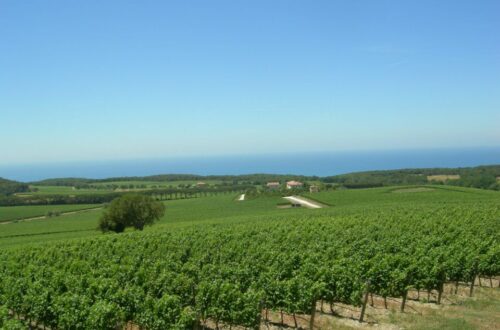Table of Contents
What Is Brindisi DOC Wine?
Brindisi DOC is one of Puglia’s most expressive wine appellations, a coastal zone on the Adriatic known for its Negroamaro-based reds and elegant rosatos. These wines reflect the sun-drenched vineyards, maritime breezes, and centuries of winemaking tradition that have made Brindisi both a seaport of global commerce and a source of soulful wines.
History of Brindisi Winemaking
The city of Brindisi has always been a gateway—first for the Romans, who exported wines from this port across the Empire, and later as a maritime hub connecting Italy to Greece and beyond. Winemaking here has endured phylloxera, shifting political landscapes, and modern agricultural reforms. Today, Brindisi DOC represents a proud continuity of Negroamaro’s dominance, enriched by local grapes like Susumaniello and Malvasia Nera.
Cultural traditions, such as the Good Friday “Processione dei Misteri”, highlight the city’s deep connection between land, ritual, and community—a context that infuses Brindisi’s wines with both cultural and spiritual identity.
Geography & Terroir of Brindisi DOC
Located along Puglia’s Adriatic coast, the Brindisi DOC benefits from:
- Soils: Sandy, limestone-rich, and fertile alluvial plains
- Climate: Hot Mediterranean summers tempered by sea breezes
- Proximity to the sea: Coastal influence ensures freshness, acidity, and salinity
This terroir shapes wines that are ripe, structured, yet balanced, with reds showing power and rosatos offering crisp vibrancy.
Brindisi DOC Grapes & Blends
The appellation rules highlight Negroamaro as the signature grape:
- Rosso (Red):
- Minimum 70% Negroamaro
- Blended with Susumaniello, Malvasia Nera, Sangiovese, Montepulciano
- Minimum 70% Negroamaro
- Rosato (Rosé):
- Same base as Rosso, emphasizing Negroamaro’s fruity elegance
- Same base as Rosso, emphasizing Negroamaro’s fruity elegance
- Riserva:
- Longer aging, richer structure, and higher alcohol (minimum 12.5%)
- Longer aging, richer structure, and higher alcohol (minimum 12.5%)
- Bianco (White): Less common, featuring Malvasia Bianca, Chardonnay, Trebbiano
Winemaking Rules & DOC Requirements
- Rosso & Rosato: Minimum 70% Negroamaro
- Aging: Riserva requires at least 24 months (with 6 in oak)
- Alcohol levels:
- Rosso & Rosato: 11.5% minimum
- Riserva: 12.5% minimum
- Rosso & Rosato: 11.5% minimum
These rules ensure wines maintain their authentic Puglian identity while allowing stylistic flexibility for producers.
Key Facts at a Glance
- Region: Puglia, Adriatic coast near Brindisi
- Established: 1979
- Styles: Rosso, Rosato, Bianco, Riserva
- Signature Grape: Negroamaro
- Unique Feature: Blend of coastal freshness and southern intensity
Tasting Notes by Style
- Rosso: Deep ruby; aromas of dark cherry, plum, leather, and Mediterranean herbs; full-bodied with soft tannins.
- Rosato: Coral pink; notes of wild strawberry, citrus peel, and rose petals; refreshing and versatile.
- Riserva: Garnet-hued; complex layers of dried figs, spice, tobacco, and balsamic depth.
Serving Temperatures & Pairing Ideas
- Rosso: Serve at 16–18°C; pairs with grilled lamb, orecchiette with ragu, aged caciocavallo cheese.
- Rosato: Serve chilled at 10–12°C; ideal with seafood pasta, fried calamari, and burrata.
- Riserva: Perfect for braised meats, wild game, or hearty stews.
Where to Buy Brindisi DOC Wines
Brindisi DOC wines are moderately priced, offering excellent value for their quality:
- Standard Rosso & Rosato: $10–15 USD
- Riserva: $20–30 USD
Look for producers like Cantine Risveglio Agricola or Cantine Due Palme (external link suggestion).
FAQs About Brindisi DOC
Is Brindisi DOC only red wine?
No, while Negroamaro-based reds and rosatos dominate, small amounts of white wine are also produced.
What makes Brindisi DOC unique compared to Salice Salentino?
Both rely on Negroamaro, but Brindisi’s coastal terroir gives fresher acidity and lighter structure than the richer inland wines of Salice.
Can Brindisi DOC wines age?
Yes—especially Riservas, which can evolve for 5–10 years.
Cultural Highlights & Fun Facts
- Roman Legacy: Amphorae marked “Brundisium” have been found in ancient shipwrecks.
- Susumaniello’s Comeback: Once nearly extinct, this indigenous grape is now thriving in Brindisi blends.
- Festival Connection: Brindisi’s wines are often poured during summer coastal festivals celebrating Puglia’s maritime identity.
CTA for Audience Engagement
✨ Planning a trip to Puglia? Add a glass of Brindisi DOC to your coastal journey. Sign up for our newsletter for travel guides, producer stories, and tasting tips to make your Italian wine experience unforgettable.


